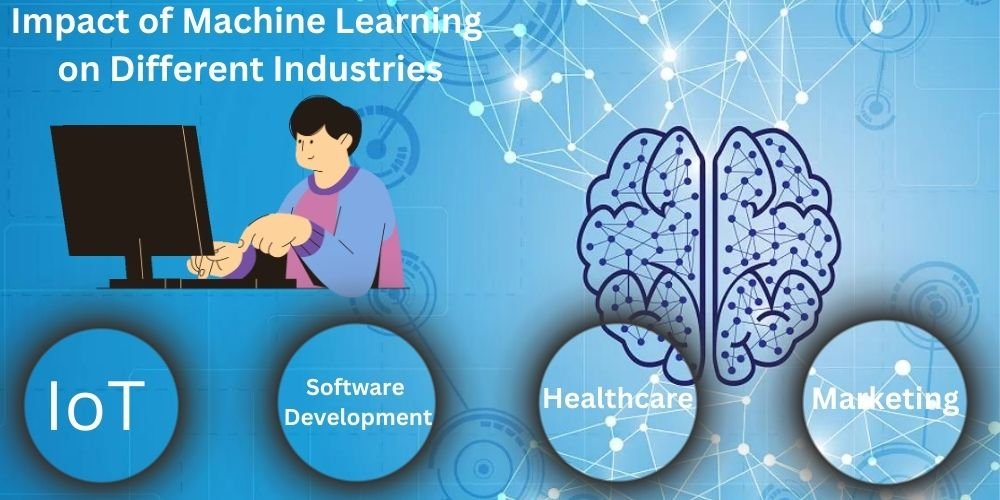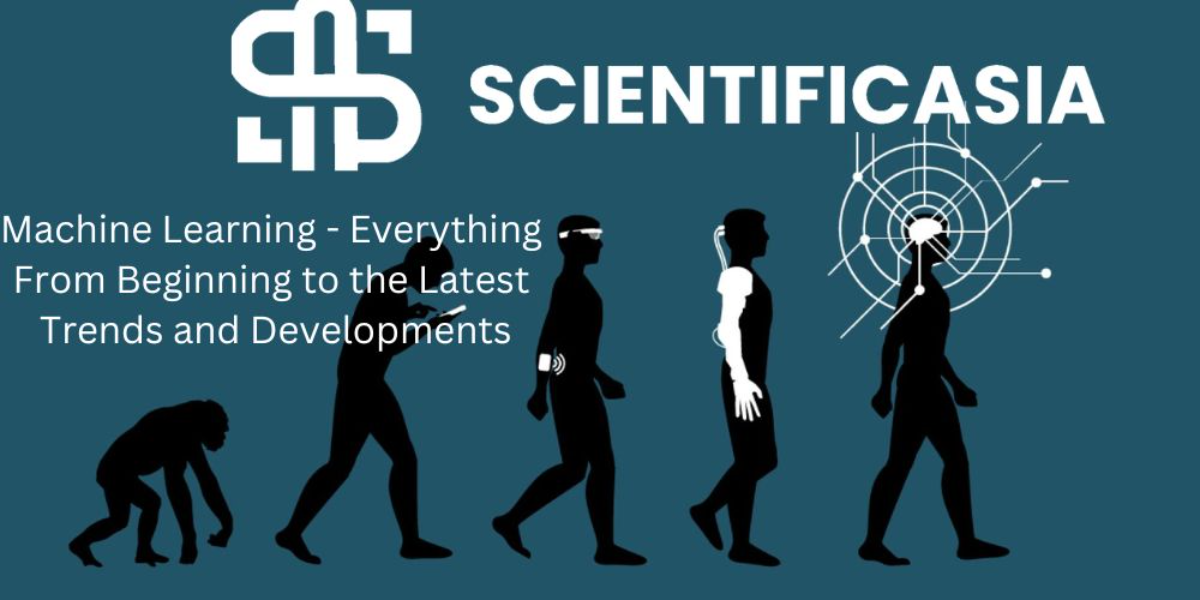Machine learning is the most trending buzzword everyone must have heard recently. From companies looking for machine learning engineers to tech enthusiasts selecting it as a career path, machine learning has the potential to revolutionize the future.
The concept of machine learning allows computer systems to learn automatically making them intelligent and reliable. We will discuss more in detail later on but as for now, consider it as the technology which promises great advancements, especially in the tech industry.
Let’s talk about numbers, the global machine learning market was valued at $21.17 billion in 2022 and is expected to grow to $209.91 billion by 2029, at a CAGR of 38.8% in the forecast period. Machine learning has become an increasingly significant tool for addressing complicated issues and boosting efficiency in a wide range of industries, from healthcare to finance to transportation, as the amount of data created by our linked world continues to expand. Machine learning is an exciting area in the continual growth of Emerging technology, with the potential to revolutionize practically every aspect of our lives.
This blog covers all the important aspects of this promising technology, from the introduction to machine learning to how it impacts the lives of users in the most fascinating way.
What is Machine Learning?
Machine learning is one of the sub-branches of artificial intelligence which empowers computer systems to learn and grow on their own without being explicitly programmed. In simple words, machine learning is the science that makes computers learn from data, recognize patterns, and make decisions based on that learning, all while continually improving their performance through feedback.
It’s similar to teaching a computer to learn on its own, exactly like a human brain, with the ultimate objective of producing intelligent machines, capable of doing activities that would otherwise require human intellect. Machine learning is an enthralling topic that has the potential to transform the way we engage with technology and make our lives simpler, more efficient, and more productive.
Some also refer to ML as rule-based programming technology. Nvidia, the world’s leading AI firm, put it as, “Machine Learning at its most basic is the practice of using algorithms to parse data, learn from it, and then make a determination or prediction about something in the world.”
What is the Difference between Artificial Intelligence and Machine Learning?

So, what is the distinction between Artificial Intelligence and Machine Learning? Consider AI to be the large umbrella under which Machine Learning is simply a small subset.
AI is a catch-all phrase for anything involving robots doing tasks that need human-like intellect, such as thinking, problem-solving, and decision-making. It is the concept that robots can perform tasks that normally require human intellect, such as speech recognition, language comprehension, and even playing games like chess or Go.
Now, Machine Learning is a subset of artificial intelligence that focuses on developing algorithms that can learn from data and improve their performance over time without being explicitly programmed. Thus, rather than directing a machine exactly what to do step by step, it’s like giving it a bunch of data and letting it figure out patterns and correlations on its own.
For instance, Let’s take AI as the parent that contains Machine Learning, which is the kid that wants to do things its own way and learn from experience. While they are connected, Machine Learning is only one method of developing Artificial Intelligence.
What are the Types of Machine Learning?

Now that you understand the difference between AI and ML, let us move on to the business end where things start to get technical. Machine learning is further divided into categories and each type represents a specific learning and behavior process. Splitting machine learning into these three classes allows us to better understand the various techniques to develop and train machine learning models.
Each kind has distinct strengths and drawbacks and is best suited for certain purposes. Understanding the various forms of machine learning allows us to choose the best technique for the problem at hand and construct more effective and efficient machine learning systems. The main three types are supervised learning, unsupervised learning, and reinforcement learning.
Supervised Learning
Supervised learning includes training the machine learning model with labeled data. And by labeled data we mean, the information that is already tagged, enabling the system to identify the characteristics of the data it is fed with. The model learns to generate predictions based on data points, which have previously been classed or categorized.
For example, to train a model to recognize photographs of cats and dogs, you would provide it with a set of labeled images, with each image classified as either a cat or a dog. The algorithm learns to detect patterns in photos, allowing it to make accurate predictions on new input, which is not tagged nor fed earlier to the system.
Unsupervised Learning
In contrast to the first type, unsupervised learning is the type in which we train the machine learning model on unlabeled data. Without any pre-existing labels or classifications, the model must uncover patterns and correlations in the data, all by itself.
One significant example of this process is K-means clustering. It is a typical form of unsupervised learning, in which the model clusters together similar data points based on their properties or qualities. For example, you might utilize unsupervised learning to discover various client categories by clustering customers based on their purchase history.
Reinforcement Learning
The third and most interesting type for many ML engineers is reinforcement learning. It is a completely different method of learning in which the machine learning model learns by trial and error procedures. Based on its behaviors, the model interacts with its surroundings and receives feedback in the form of rewards or punishments.
Whenever it identifies the correct pattern, it earns a reward and on every false output, it receives a punishment in the form of a penalty. To maximize rewards and reduce punishments, the model learns to optimize its behavior. For example, a reinforcement learning paradigm can be used to teach a robot to traverse a robot, with the reward reaching the end of the maze and the punishment striking a wall.
How does Machine Learning Work?
Machine learning is the process of making computers intelligent using various methods. There are three main components that every ML process consumes.
Data
The core component which determines the output and efficiency of every machine learning operation is the data it is fed with. It is first gathered, preprocessed, and then separated into training and testing data. The training data is used to create a model, a mathematical representation of the data’s patterns and connections. The larger the dataset, the better the output efficiency.
Algorithm
In machine learning, an algorithm is simply a series of instructions or rules that computer software follows to execute a certain job, such as prediction or data clustering.
Consider it a recipe for a machine learning model: It specifies the steps that the computer must follow to learn from data and generate correct predictions. There are several types of algorithms used in machine learning, each with its own set of advantages and disadvantages.
Decision trees, neural networks, and support vector machines are some typical examples. Data scientists guarantee that machine-learning models are as accurate and efficient as possible by picking the proper algorithm for a certain task.
Model
The model’s parameters are then adjusted using an algorithm to minimize the difference between the expected and actual outputs of the training data. This is known as optimization or training. To build a model, we must first select an algorithm that is well-suited to the job at hand.
The model is then trained by feeding it vast quantities of data and modifying the algorithm’s parameters until it can reliably predict the output for a particular input. Once trained, the model can be used to predict the outcomes of new, previously unknown data.
There are seven stages generally involved in a machine learning process lifecycle.
- Data Collection
- Data Preparation
- Model Preparation
- Model Training
- Model Evaluation
- Parameter Tuning
- Predictions
Impact of Machine Learning on Different Industries

Machine learning has a significant impact on various tech offerings. It can easily improve the performance of the existing system by learning from previous experiences and outcomes. And as of 2023, many businesses are implementing ML solutions to enhance their efficiency and business offerings. Globally big names such as Microsoft and Google are investing great amounts to broaden the machine learning development landscape.
The google cloud machine learning solutions are great for businesses with pay-as-you-go payment methods. These google machine-learning workspaces provide a convenient development environment. The tech sector largely adopts modern practices and is envisioned to bring more advancements in the world of machine learning. Here are the different areas within the tech industry that are consuming this revolutionary AI technology to up their game in the market.
IoT
Machine learning can significantly improve IoT (Internet of Things) development. To understand how IoT machine learning works, let us take a use case of a smart traffic monitoring system that tracks traffic patterns in a city. It learns traffic flows, congestion patterns, and other factors that affect traffic by collecting data from sensors and cameras located across the city. We can find patterns and forecast future traffic conditions by applying ML algorithms to this data, allowing us to adjust traffic lights and other infrastructure to enhance traffic flow and minimize congestion.
Since it allows us to extract insights and predictions from large volumes of data generated by IoT sensors, machine learning (ML) can be a powerful tool for designing Internet of Things (IoT) applications. With ML, IoT software developers can uncover patterns and trends from data that would be difficult or impossible to spot using standard approaches.
Software Development
Machine learning has the ability to revolutionize software development by helping developers to:
- Automate tasks
- Detect errors
- Improve code efficiency
Machine learning methods are used to detect faults and mistakes in code, decreasing the time and effort necessary for manual testing and debugging. They also enhance code architecture and optimize code performance, resulting in speedier and more efficient software.
One significant example is AI coding tools such as Open AI codex, AlphaCode, and GitHub Copilot which improve software development using a predictive coding approach. These solutions utilize machine learning techniques to predict what code a developer will write next based on their previous coding patterns and habits. These tools can save developers substantial time and effort in various circumstances while lowering the chance of mistakes and problems by proposing code snippets and even entire basic functions.
Healthcare
Machine learning has the ability to completely transform healthcare! It can assist physicians and researchers in rapidly and reliably analyzing massive volumes of data, resulting in better diagnoses, treatments, and results for patients. For example, ML algorithms can examine medical photos and uncover patterns that the human eye may miss, resulting in earlier and more accurate diagnoses.
Machine learning may also be used to forecast the likelihood of specific diseases or problems emerging, allowing clinicians to intervene early and prevent them from forming. Ultimately, machine learning is a strong tool that may assist healthcare workers in making well-informed decisions, thus improving patient outcomes.
Read more about Health:
Mouth Larva Causes and Their Impact on Humans
Understanding the Impact of Phytochrome B (PHYB) on Plant Life Cycle
Exploring Cytokinesis and its Crucial Role in Organisms
Nucleosome Key Insight into DNA Packaging and Gene Regulation
Haplotype A Guide to Genetic Code of Inheritance
Pleiotropy The Impact of Single Gene Variation on Life
Marketing
Advanced machine learning concepts are making their way into almost every industry and marketing is no different. Machine learning solutions in digital marketing help businesses find patterns in user activities on a website. This helps them predict the further behavior of users and quickly optimize advertising offers.
For instance, whenever you browse any e-commerce website, there are tons of pop-ups and notifications asking for cookies, location, and other site preferences. When a user likes or dislikes some products on the website, the machine learning algorithm on the backend learns different user behaviors.
And when there are millions of customers browsing websites every day, the dataset grows to allow the system to identify the type of products people like the items they ignore and the services they love to use. This helps businesses to better market their products in the future.
The statistics indicate the same as it is predicted that the global market value of ML in marketing will reach $47.32 billion by 2025.
Final Thoughts
Machine learning is the core aspect of artificial intelligence that makes machines intelligent. It is the process by which a computer system learns from various types of data. The future of machine learning appears bright, and we’re only touching the surface of its possibilities. As ML algorithms improve and more data becomes available, we will witness more efficient solutions being implemented in a variety of industries, from banking to transportation to agriculture.
The machine learning market is experiencing rapid growth. This growth is being driven by factors such as the increasing demand for big data analytics, the rising adoption of cloud-based technologies, and the growing use of machine learning in various applications, including healthcare, finance, and retail. In addition, the development of advanced machine learning algorithms and the availability of large amounts of data are also contributing to the growth of the market. North America is currently the largest market for machine learning, while Asia-Pacific is expected to experience the highest growth rate in the coming years.
One of the most interesting prospects is the development of autonomous systems capable of learning from their surroundings and making decisions on their own, resulting in enhanced efficiency and production. The potential for machine learning is essentially limitless as we continue to create new algorithms and data processing approaches.
Read more:
How Robotics Technology is Shaping the Future A Comprehensive Overview
From Drones to Robots The Latest Trends in Agriculture Technology
















